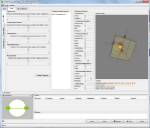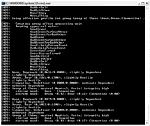What is ALMA?
ALMA is a computational model for the real-time simulation of three basic affect types that human beings can experience. ALMA supports several methods to generate affect and it realizes the interference of different affect types. Based on a kind of cognitive appraisal different affect types are simulated in a hierarchical generation process. Hence, the name ALMA, which stands for A Layered Model of Affect.
Motivation
Behavior from human beings, especially interpersonal communication behavior, is essentially influenced by affect. Simulated affect can be exploited for virtual characters used in human computer interfaces in order to make them more believable. A simulation of affect that considers more aspects of human affect is the key for the modeling of a more natural behavior of virtual characters.
The aim is the design and realization of a computational model of affect that allows the simulation of plausible affect in real-time. The focus thereby is the simulation of mood and its interaction with other affect types.
After an analysis of existing computational models of affect, actual psychological theories about affect are investigated for an employment in a computational model. As a result a model has been created that represents emotions, moods, and personality and their particular relations. Furthermore new input structures for the computation of emotions are developed. Both enable, for the first time, a continuous simulation of mood changes in eight mood classes that is based on an extended emotion computation with different intensity decay functions [Gebhard 05]. Finally, simulated emotions and moods have been evaluated by a study [Gebhard, Kipp 06]. The results show that affect is rated plausible.
Technical Background
ALMA is a computational model of real-time affect for virtual characters. The simulation of affect supports: 24 emotion types, 8 mood types, and 5 personality types that cover short, medium, and long term affect. The use of this model requires two phases:
ALMA is implemented in JAVA (Version 1.7 or greater). It has been tested on several os platforms: Windows XP, Mac OS X 10.(4,5). It should run at any os platform that fully supports JAVA 1.7 and above.
Related Publications
Focus on Model
- Michael Kipp, Thomas Dackweiler, and Patrick Gebhard
Designing Emotions - An Empirical Approach to Realistic Affect Simulation.
In: KI Journal, Special Issue on Emotions & Computing, Springer, 2011.
- Nikolaus Bee, Elisabeth Andr\E9, Thurid Vogt and Patrick Gebhard
Close Engagements with Artificial Companions: Key social, psychological, ethical and design issues
In: Key social, psychological, ethical and design issues, chapter The use of affective and attentive cues in an empathic computer-based companion, pages 131-142. John Benjamins, 2010.
- Nikolaus Bee, Elisabeth Andr\E9, and Patrick Gebhard
First ideas on the use of affective cues in an empathic computer-based companion.
In: In Proceedings of AAMAS '09 Workshop on Empathic Agents, 2009
- Patrick Gebhard
Emotionalisierung interaktiver Virtueller Charaktere - Ein mehrschichtiges Computermodell zur Erzeugung und Simulation von Gef\FChlen in Echtzeit, Dissertation, Lehrstuhl Prof. Wahlster, Saarland University, 2007
- Patrick Gebhard and Kerstin H. Kipp
Are Computer-generated Emotions and Moods plausible to Humans? (pdf, 573 KB, 14 pages, English)
In: Proceedings of the 6th International Conference on Intelligent Virtual Agents (IVA'06), 343-356, Marina Del Rey, USA, 2006.
- Patrick Gebhard
ALMA - A Layered Model of Affect (pdf, 761 KB, 8 pages, English)
In: Proceedings of the Fourth International Joint Conference on Autonomous Agents and Multiagent Systems (AAMAS'05), 29-36, Utrecht, 2005.
- Patrick Gebhard, Martin Klesen, Thomas Rist
Coloring Multi-Character Conversations through the Expression of Emotions (pdf, 360 KB, 13 pages, English)
In: Proceedings of the Tutorial and Research Workshop on Affective Dialogue Systems (ADS'04), 128-141, Kloster Irsee, June 14-16, 2004.
- Patrick Gebhard, Michael Kipp, Martin Klesen, Thomas Rist
Adding the Emotional Dimension to Scripting Character Dialogues (pdf, 271 KB, 9 pages, English)
In: Proceedings of the 4th International Working Conference on Intelligent Virtual Agents (IVA'03), 48-56, Kloster Irsee, 2003.
Focus on Application
- Patrick Gebhard, Marc Schröder, Marcela
Charfuelan, Christoph Endres, Michael Kipp, Sathish Pammi, Martin Rumpler, and Oytun Türk
IDEAS4Games: Building Expressive Virtual Characters for Computer Games (pdf, 2 MB, 14 pages, English)
To appear in: Proceedings of the 8th International Conference on Intelligent Virtual Agents (IVA'08), Tokyo, Japan, 2008.
- Martin Klesen and Patrick Gebhard
Affective Multimodal Control of Virtual Characters
In: International Journal of Virtual Reality 6(4):43-53, 2007
- Norbert Reithinger, Patrick Gebhard, Markus L\F6ckelt, Alassane Ndiaye, Norbert Pfleger, Martin Klesen
VirtualHuman - Dialogic and Affective Interaction with Virtual Characters (pdf, 1 MB, 8 pages, English)
In: Proceedings of the 8th International Conference on Multimodal Interfaces (ICMI'06), Banff, Canada, 2006.


